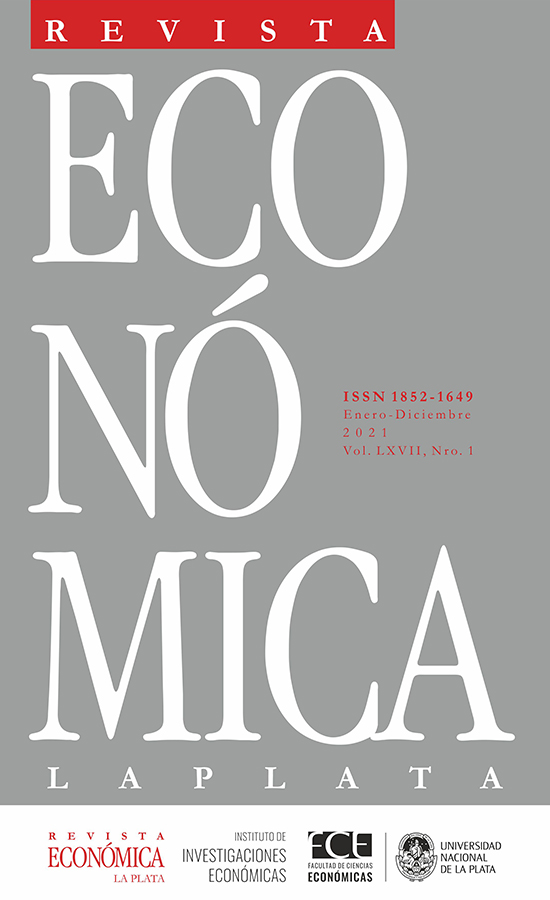Demographic Dividends and Economic Growth in Latin America
A Low and Middle-Income Trap Equilibrium
DOI:
https://doi.org/10.24215/18521649e020Keywords:
demographic dividends, economic growth, support ratioAbstract
The objective of this paper is to analyze the possibility of a low and middle-income trap for the Latin American countries due to demographic changes. Based on the use of a panel data from 16 countries during the period from 1970 to 2014, it is identified that the growth of GDP per capita is related with the first demographic dividend. However, given the dynamics of the fertility rate, we identify a latent risk of low and middle-income trap equilibrium in the long term unless there is an increase in the saving rate, investment and, therefore, the long-term productivity.
Downloads
Metrics
References
Albrieu, R., & Fanelli, J. (2013). On the macroeconomic and financial implications of the demographic transition. IX Meeting of the Working Group on Macroeconomc Aspects of Intergenerational Transfers (págs. 3-8). Faculty of Economics, University of Barcelona.
Apella, I., Packard, T., Joubert, C., & Zumaeta, M. (2019). Retos y Oportunidades del Envejecimiento en Chile. Santiago, Chile: World Bank. Available at: http://documentos.bancomundial.org/curated/es/591471558704698806/Retos-y-Oportunidades-del-Envejecimiento-en-Chile
Aravena, C., Escobar, L., & Hofrman, A. (2015). Fuentes del crecimiento económico para América Latina y el Caribe, 1990-2013. Economic Commission for Latin America and the Caribbean, Serie Macroeconomía del Desarrollo 164.
Aravena, C., & Hofman, A. (2014). Crecimiento económico y productividad en América Latina. Una perspectiva por industrias-base de datos LA KLEMS. Economic Commission for Latin America and the Caribbean, Serie Macroeconomía del Desarrollo 152.
Becker, G. (1960). An Economic Analysis of Fertility. In Becker, G. S. (ed.), Demographic and Economic Change in Developed Countries, Princeton University Press.
Caselli, F. (2004). Accounting for cross-country income differences. NBER working paper 10828
Fanelli, J. (2015). Demography and macroeconomic. Opportunities and risks in dividend-era Argentina. In Gragnolati, M., Rofman, R., Apella, I., & Troiano, S., 2015. As time goes by in Argentina. Economic opportunities and challenges of the demographic transition. Direction in Development. World Bank, Washington, D. C.
Feenstra, R., Inklaar, R., & Timmer, M. (2015). The next generation of the Penn World Table. American Economic Review, 105(10), 3150-82.
Galor, O. (2011). Unified growth theory. Princeton University Press.
Ha, J., & Lee, S. H. (2016). Demographic dividend and Asia’s economic convergence towards the US. The Journal of the Economics of Ageing, 8(2016), 28–41.
Lee, R., Mason, A., & Miller, T. (2003). From transfers to individual responsibility: implications for savings and capital accumulation in Taiwan and the United States. Scandinavian Journal of Economics, 105(3), 339-57.
Loayza, N. (2008). El crecimiento económico en Perú. Economía, 31(61), 9-25.
Mason, A., & Lee, R. (2006). Back to basics: what is the demographic dividend. Finance & Development (Washington, D.C.: International Monetary Fund), 16-17.
Mason, A., & Lee, R. (2007). Transfers, capital, and consumption over the demographic transition in population aging. Intergenerational transfers and the macroeconomy. In Clark, R., Ogawa, N. y Mason, A. (eds) Cheltenham, UK: Edward Elgar 128-162.
Mason, A., & Lee, R. (2011). Population aging and the generational economy: a global perspective. Cheltenham, UK, Edward Elgar.
Nelson, R., & Phelps, E. (1966). Investment in humans, technological diffusion, and economic growth. American Economic Review, 56(2), 69–75.
Rofman, R., & Apella, I. (2020). When We’re Sixty-Four: Opportunities and Challenges for Public Policies in a Population-Aging Context in Latin America. International Development in Focus. Washington, DC: World Bank. doi:10.1596/978-1-4648-1605-5.
Young, A. (1995). The tyranny of numbers: confronting the statistical realities of the East Asian growth experience. The Quarterly Journal of Economics, 110(3), 641-680.
Published
How to Cite
Issue
Section
License
The material published in the journal is distributed under a Creative Commons Attribution-NonCommercial-NoDerivatives 4.0 International (CC BY-NC-ND 4.0) license. This license requires proper credit to be given, a link to the license to be provided, and changes to be indicated. It does not permit commercial use of the work, and if the work is remixed, transformed, or otherwise modified, distribution of such modification is not allowed.


























